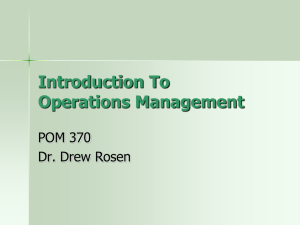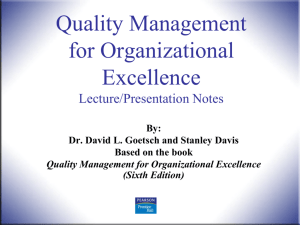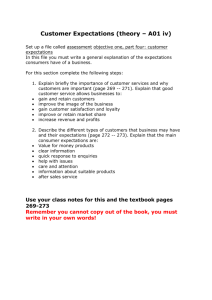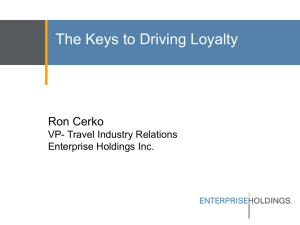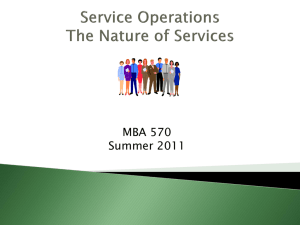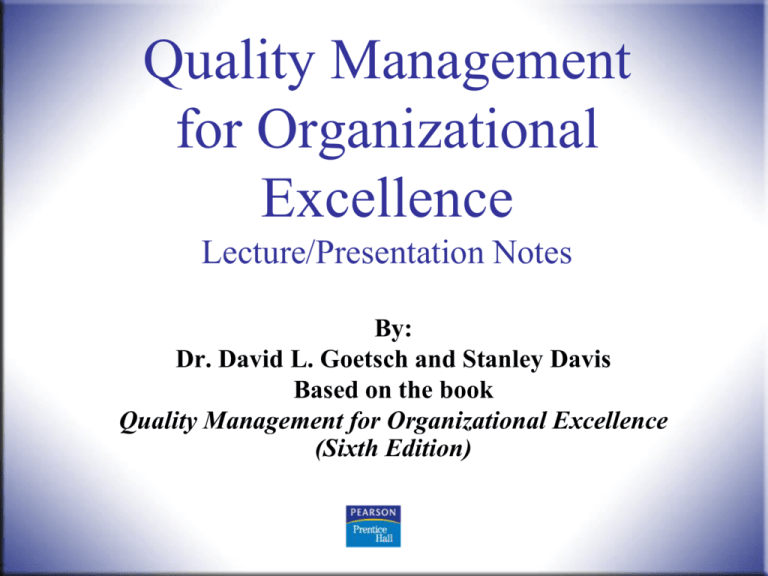
Quality Management
for Organizational
Excellence
Lecture/Presentation Notes
By:
Dr. David L. Goetsch and Stanley Davis
Based on the book
Quality Management for Organizational Excellence
(Sixth Edition)
Quality Management, 6th ed.
Goetsch and Davis
1
© 2010 Pearson Higher Education,
Upper Saddle River, NJ 07458. • All Rights Reserved.
Seven:
Customer Satisfaction, Retention, and
Loyalty
MAJOR TOPICS
Understanding Who Is a Customer
Understanding Customer-Defined Quality
Identifying External Customer Needs
Identifying Internal Customer Needs
Communicating with Customers
Using Customer Feedback to Make Design
Improvements
Quality Management, 6th ed.
Goetsch and Davis
2
© 2010 Pearson Higher Education,
Upper Saddle River, NJ 07458. • All Rights Reserved.
Seven:
Customer Satisfaction, Retention, and Loyalty
(Continued)
Customer Satisfaction Process
Customer-Defined Value
Customer Value Analysis
Customer Retention
Establishing a Customer Focus
Recognizing the Customer-Driven Organization
Value Perception and Customer Loyalty
Customer Loyalty Model
Customer Loyalty versus Customer Profitability
Customers as Innovation Partners
Quality Management, 6th ed.
Goetsch and Davis
3
© 2010 Pearson Higher Education,
Upper Saddle River, NJ 07458. • All Rights Reserved.
Seven:
Customer Satisfaction, Retention, and Loyalty
(Continued)
Historically, customers were considered who used a
company’s products and suppliers were outsiders who
provided the materials needed to produce the products. A
more contemporary view is that every organization has
both internal and external customers. An external
customer is the one referred to in the traditional
definition. An internal customer is any employee whose
work depends on that of employees whose work precedes
his or hers.
Quality Management, 6th ed.
Goetsch and Davis
4
© 2010 Pearson Higher Education,
Upper Saddle River, NJ 07458. • All Rights Reserved.
Seven:
Customer Satisfaction, Retention, and Loyalty
(Continued)
In a total quality setting, customers define quality.
Therefore, customer satisfaction must be the highest
priority. Customer satisfaction is achieved by
producing high-quality products that meet or exceed
expectations. It must be renewed with each
purchase. The key to establishing a customer focus
is to put employees in touch with customers so that
customer needs are known and understood.
Quality Management, 6th ed.
Goetsch and Davis
5
© 2010 Pearson Higher Education,
Upper Saddle River, NJ 07458. • All Rights Reserved.
Seven:
Customer Satisfaction, Retention, and Loyalty
(Continued)
The six-step strategy for identifying customer needs is
as follows: speculate about results, develop an
information-gathering plan, gather information, analyze
the results, check the validity of conclusions, and take
action.
Customer needs are not static. Therefore, constant
contact with customers is essential in a total quality
setting. Whenever possible, this contact should be in
person or by telephone. Written surveys can be used,
but they will not produce the level of feedback that
personal contact can generate.
Quality Management, 6th ed.
Goetsch and Davis
6
© 2010 Pearson Higher Education,
Upper Saddle River, NJ 07458. • All Rights Reserved.
Seven:
Customer Satisfaction, Retention, and Loyalty
(Continued)
Quality function deployment (QFD) is a mechanism for
putting into operation the concept of building in quality.
It makes customer feedback a normal part of the
product development process, thereby improving
customer satisfaction.
Measuring customer satisfaction alone is not enough.
Many customers who defect are satisfied. Organizations
should, in addition, measure customer retention.
Organizations should go beyond satisfying customers to
creating value for them in every supplier-customer
interaction.
Quality Management, 6th ed.
Goetsch and Davis
7
© 2010 Pearson Higher Education,
Upper Saddle River, NJ 07458. • All Rights Reserved.
Seven:
Customer Satisfaction, Retention, and Loyalty
(Continued)
The customer loyalty model consists of four
components: 1) business performance, 2) global
perceptions, 3) loyalty behaviors, and 4) financial
outcomes.
The goal of organizations should be more than just
earning customer loyalty; it should be earning the
loyalty of profitable customers. Organizations should
never assume a positive correlation between customer
loyalty and profitability, nor should they assume that a
customer who is initially profitable will always be
profitable.
Quality Management, 6th ed.
Goetsch and Davis
8
© 2010 Pearson Higher Education,
Upper Saddle River, NJ 07458. • All Rights Reserved.
Seven:
Customer Satisfaction, Retention, and Loyalty
(Continued)
An innovative approach to product development that is
gaining acceptance is turning customers into innovation
partners. With this approach, the customer is given a
technological tool kit for designing his or her own
products and making product innovations. This approach
is implemented using the following steps:
develop a tool kit for customers that is easy to use
increase the flexibility of your own production processes
carefully select the first customers to use your took kit
continually improve your tool kit
adapt your business practices to suit the innovation
partnership approach.
Quality Management, 6th ed.
Goetsch and Davis
9
© 2010 Pearson Higher Education,
Upper Saddle River, NJ 07458. • All Rights Reserved.

